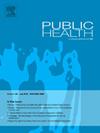奥地利2024/2025季节SARS-CoV-2感染人数:国家废水数据分析
IF 3.2
3区 医学
Q1 PUBLIC, ENVIRONMENTAL & OCCUPATIONAL HEALTH
引用次数: 0
摘要
目的适应SARS-CoV-2政策需要掌握当代感染趋势信息。由于不再积极追踪SARS-CoV-2感染情况,因此需要采取间接措施,例如根据废水数据进行估计。研究设计这是一项回顾性观察性研究。方法基于废水监测数据,估计奥地利2024年4月1日至2025年3月31日的SARS-CoV-2总感染人数。所应用的方法建立在以前发表的一种方法的基础上,该方法通过将废水测量值与血清流行率数据拟合来估计大流行期间的感染流行率。结果在2024年4月1日至2025年3月31日期间,我们估计奥地利有250万新感染病例。活跃感染者在9月下旬达到33.7万人的峰值,此后有所下降。与往年相比,冬季的感染率大大降低。结论从2020年开始,我国出现了最早的年度秋冬高峰和最低的年度感染。政策制定者、医生和高危人群应了解正在发生的季节性SARS-CoV-2感染浪潮及其时间的可变性。本文章由计算机程序翻译,如有差异,请以英文原文为准。
Number of Austrian SARS-CoV-2 infections in the 2024/2025 season: Analysis of national wastewater data
Objectives
Adaptation of SARS-CoV-2 policies requires information on contemporary infection trends. As SARS-CoV-2 infections are no longer actively tracked, indirect measures such as estimations based on wastewater data are needed.
Study design
This is a retrospective observational study.
Methods
We estimated total SARS-CoV-2 infections in the entire population of Austria from April 1, 2024, to March 31, 2025, based on wastewater monitoring data. The applied method builds on a previously published approach that estimated infection prevalence during the pandemic by fitting wastewater measurements to seroprevalence data.
Results
Between April 1, 2024, and March 31, 2025, we estimate 2.5 million new infections in Austria. Active infections peaked at 337,000 in late September and decreased thereafter. Infection rates in winter were substantially lower compared to previous years.
Conclusion
The findings indicate the earliest annual fall/winter peak and the lowest annual infections since 2020. Policy makers, physicians and high-risk individuals should be aware of the ongoing seasonal SARS-CoV-2 infection waves and their variability in timing.
求助全文
通过发布文献求助,成功后即可免费获取论文全文。
去求助
来源期刊

Public Health
医学-公共卫生、环境卫生与职业卫生
CiteScore
7.60
自引率
0.00%
发文量
280
审稿时长
37 days
期刊介绍:
Public Health is an international, multidisciplinary peer-reviewed journal. It publishes original papers, reviews and short reports on all aspects of the science, philosophy, and practice of public health.
 求助内容:
求助内容: 应助结果提醒方式:
应助结果提醒方式:


